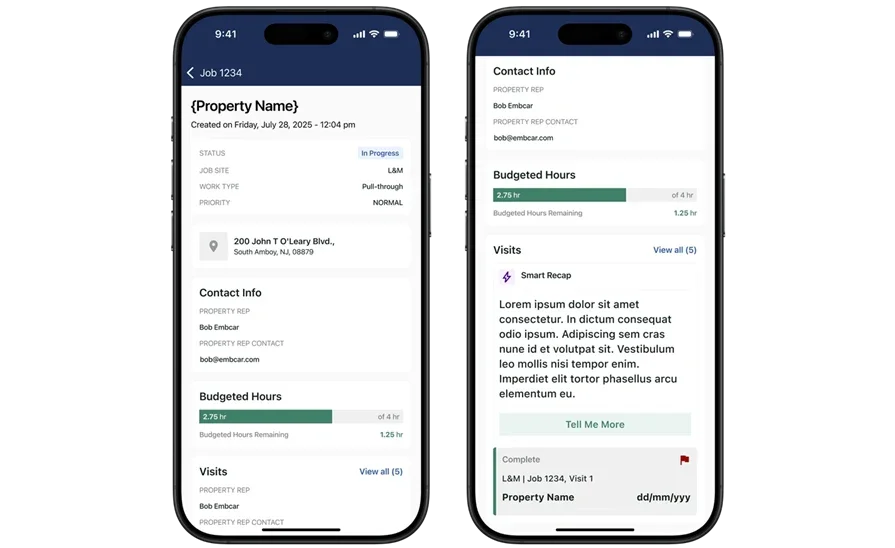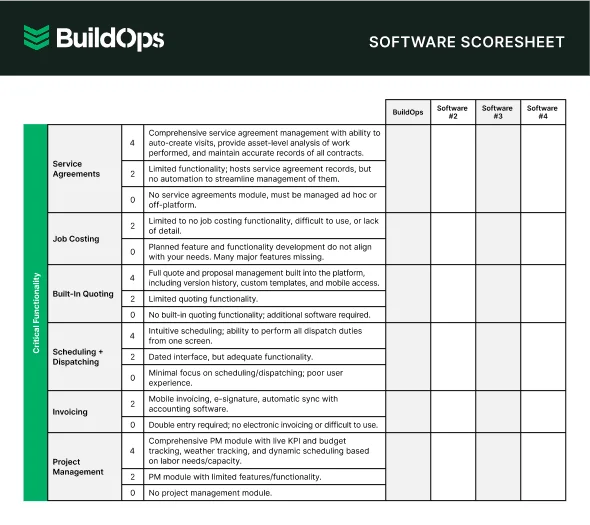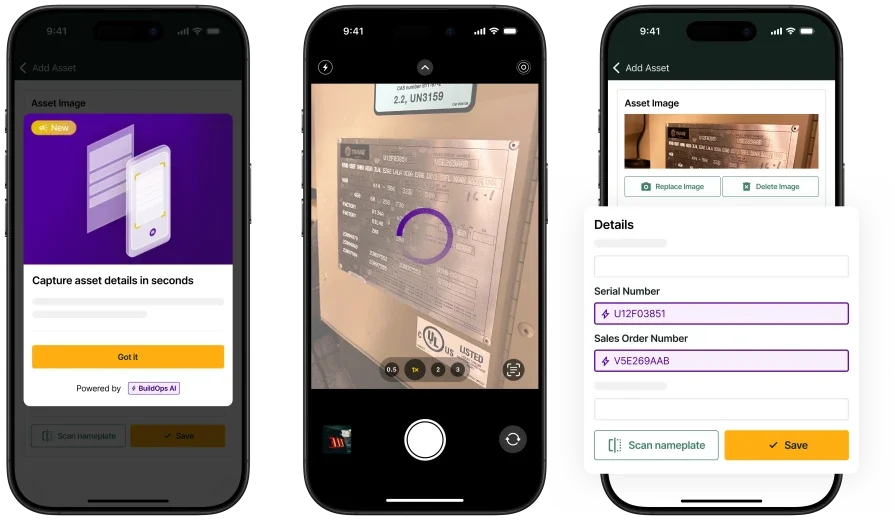Managing field jobs as a subcontractor means keeping quotes tight, schedules tighter, and making sure no task slips through the cracks. You’re constantly coordinating with GCs, juggling change orders, and trying to keep your techs moving without missing a beat. That’s where subcontractor project management software comes in—giving your team one place to quote jobs, dispatch crews, track work, and bill without delays.
From quoting to completion, this kind of software connects the dots between field and office. It’s not just about keeping organized—it’s about staying competitive in an industry where margins can shrink fast. If your team is still bouncing between spreadsheets, whiteboards, and texts, it’s time to look at tools designed for subcontractors in the field. Many of these solutions also tie directly into your field service management stack, so everything from job quoting to crew tracking happens in sync.
Here’s what we’ll cover:
- Choosing the right subcontractor project management software
- 6 key features to look for in a project management software for subcontractors
- Best for commercial
- Best for residential
- Best for general contractors
- Other notable subcontractor project management tools
- 7 benefits of using subcontractor project management software
- 4 important project management software FAQs answered for subcontractors
Before diving into software comparisons, it helps to ask the real questions. Are your quotes accurate? Can your team update job info in real time? How often are jobs held up by delays in communication or missed paperwork? If any of those hit close to home, it might be time to rethink how you're managing your field service quotation management system.
Choosing the right subcontractor project management software
No two subcontractors run jobs the same way. Some crews are moving fast on high-volume service calls. Others are deep into complex, multi-phase projects with strict coordination between field teams and GCs. What ties all of them together? The need for subcontractor project management software that fits the way they actually work on-site—day in and day out.
Before committing to a platform, ask yourself what you're trying to fix. Are missed updates costing you time? Are quotes falling out of sync with job costs? You're not buying tools—you’re removing friction from how your team handles field work. Start with these five areas:
- Job flow and project load - Are you managing one-off service jobs, recurring site visits, or longer project timelines with multiple dependencies? Do you need a system that handles shifting job scopes, change orders, and mid-project requests without slowing your crew down? How often do you coordinate with multiple trades on the same site?
- Field updates and crew coordination - Can your techs push updates from the field instantly—without waiting until they’re back at the office? Is everyone working off the same job details, scope, and deadlines? What happens when something changes mid-day—does your software keep everyone aligned?
- Scheduling and logistics - Can your office easily see which techs are available, where they’re assigned, and what materials they need for the day? Are last-minute changes causing confusion or wasted trips? Does your dispatching process feel reactive instead of planned?
- Cost tracking and billing - Are job costs lining up with what you quoted? How easy is it to track time and materials as work happens? Is your billing team stuck chasing techs for missing hours, or sorting through handwritten notes just to invoice a job?
- Features - Does the platform support change orders, RFIs, daily logs, and field photos—without needing five other tools? Can your crew actually use it, or does it sit unused? Will it connect with your estimating, accounting, or time-tracking systems?
Next, we’ll break down six must-have features that show up in the strongest project management software for subcontractors—and how to spot the ones that are actually built for life in the field.
6 key features to look for in a project management software for subcontractors
When your crew is out in the field, every minute counts. From service calls to multi-phase installations, subcontractors need tools that don’t just track jobs—they keep them moving. Subcontractor project management software should cover every phase of the job lifecycle, from quoting to dispatching to getting paid. These six features aren’t add-ons—they’re the core of how project management software for subcontractors delivers real value.
1. Smart scheduling and real-time dispatching
Coordinating techs across jobsites starts with clear visibility into your schedule. That means having field service scheduling tools that let you assign based on skill set, proximity, or job urgency. Match that with a dispatching system for subcontractors that updates crews instantly and adapts to emergencies. For instance, say your team is finishing a job ahead of schedule, and a nearby project is falling behind. Instead of wasting hours waiting on a supervisor’s call, your dispatcher reassigns tasks on the spot, sends directions to the tech’s phone, and keeps the GC in the loop. That kind of agility keeps your day on track.
2. Integrated quoting and estimating
You can’t afford to be slow—or sloppy—when quoting jobs. The best quoting software for subcontractors makes it easy to build accurate, itemized quotes tied to job history and materials. It should also allow quick revisions in the field. Say a client decides mid-site visit to upgrade the scope—adding two more outlets to a tenant buildout. Instead of promising to "update the office later," your foreman adjusts the quote on the spot, shows the change to the client, and gets a signature. No backtracking, no guesswork.
3. Mobile access for field techs
If your techs can’t access job info from the field, delays stack up fast. A solid technician mobile app gives your team the power to view job details, log updates, upload photos, and track time without calling into the office. Let’s say a tech runs into a reroute on-site due to hidden conduit. Instead of phoning it in or scribbling a note, they snap a photo, upload a field update, and mark it for approval—all from their phone. You’ve got real-time documentation and zero confusion back at the office.
4. Time tracking and labor logging
Tracking hours accurately is a must for billing, reporting, and compliance. Time tracking tools for subcontractors help field techs log hours from the jobsite, keeping payroll tight and preventing missed labor costs. Picture a job that spans multiple days across different sites. Your crew clocks in and out through their app at each location, giving your office a clean labor log tied to each work order. No paper timesheets. No late submissions. No lost revenue.
5. Fast invoicing and payment collection
The longer it takes to invoice, the longer you wait to get paid. Look for invoicing tools that auto-generate invoices from job logs and payment processing features that let customers pay digitally—on the spot. Say, for example, the job wraps at 3 p.m., and the tech logs completion. By 3:15, the office has reviewed the ticket, sent the invoice, and the client has already paid through a secure link. No delay, no chasing paperwork, no waiting two weeks for a check.
6. Custom reporting and job insights
You can’t fix what you can’t see. Reporting tools give you job-level insights, labor costs, quote accuracy, and crew performance in one dashboard. Whether you’re tracking one job or 20, it should be clear what’s on time, what’s over budget, and what’s holding things up. Imagine your profit margins slipped last month. With job insights in hand, you notice rework is spiking on one specific crew. Now you know exactly where to focus your training—and protect your bottom line.
Other valuable features to look for in a subcontractor project management software
Once you've nailed down the essentials—scheduling, quoting, dispatching, and billing—there are other tools that can make life a lot easier on the job. These features might not be mission-critical, but they can save your office time, help your techs move faster, and tighten up the details that often get missed. Here are a few worth considering when evaluating subcontractor project management software.
- Fleet tracking and management - A built-in fleet tracking tool helps subcontractors monitor vehicle location, fuel use, and maintenance needs across your service trucks. With fewer breakdowns and better route planning, you reduce delays and avoid unexpected downtime in the field.
- Customer relationship tracking - A solid CRM for subcontractors keeps all your client details, job history, and site notes in one place. It’s especially useful when juggling repeat business, tracking warranty work, or keeping tabs on high-value accounts. No more flipping through spreadsheets or post-its to find what happened last job.
- Lead and job pipeline visibility - Understanding what jobs are coming down the line is key for managing crews and material planning. A subcontractor job pipeline lets you view bids, approvals, and scheduled work in one simple flow. It helps you avoid overbooking or scrambling to fill gaps when the calendar starts looking thin.
- Recurring work and service contracts - For subcontractors handling preventive maintenance or recurring service calls, having a service agreement tool is a big win. It automates renewal dates, task reminders, and contract terms—keeping recurring revenue predictable and clients covered without extra admin work.
These tools round out the workflow by tightening the loose ends that often slow things down. They're not always the first thing you implement, but they become invaluable once your core operations are running smoothly.
Best for commercial subcontractors: BuildOps
BuildOps is built to handle the demands of commercial subcontractors managing tight timelines, detailed estimates, and large field crews. It brings quoting, scheduling, dispatching, and billing into a single platform—keeping your field crew and office staff aligned and your jobs moving without the usual friction.
How pricing works: BuildOps offers custom pricing based on team size, required features, and overall business needs.
Features beyond project management: Includes real-time job costing, technician mobile access, customer records, and service agreement tracking—tools that save hours every week across teams.
What sets it apart for commercial: Every feature addresses the daily realities of commercial subcontractors, from tracking job costs across crews to managing multi-phase workflows.

Want to see how it performs?
Check out how BuildOps helps commercial subcontractors handle high-volume work.
Best for residential: Fieldwire
Image Source: Fieldwire
Fieldwire helps residential subcontractors stay on top of punch lists, assign tasks, and share updates in the field. The mobile-first interface works well for smaller teams with straightforward workflows. However, it lacks deeper financial tools and scalable job costing needed for subcontractors handling larger or repeat jobs.
How pricing works: Fieldwire includes a free tier with basic tools, and paid plans start around $39 per user per month.
Features beyond project management: Mobile plan viewing, photo documentation, and task messaging help keep small jobs organized.
What sets it apart for residential: Simple to use and quick to deploy, it supports task coordination but may fall short for growing operations with tighter margin control.
Best for general subcontractors: Procore
Image Source: Procore
Procore supports general contractors managing large, multi-trade projects across multiple sites. It offers robust tools for financials, document control, and collaboration. That said, its size and depth can be overwhelming for subcontractors who need something faster to implement and easier to navigate in the field.
How pricing works: Procore operates on custom quotes, which scale with usage and business size.
Features beyond project management: Includes document management, change order tracking, RFI workflows, submittals, and more.
What sets it apart for general contractors: Built for GCs running big, layered jobs—but subcontractors focused on field service might find it too complex for day-to-day needs.
Other notable subcontractor project management tools
business goals, a leaner solution might be a better fit. These tools offer focused features—some strong on estimating, others built for collaboration or budget tracking. Here are five more subcontractor project management tools worth considering.
ProjectManager
Image Source: ProjectManager
ProjectManager focuses on timeline planning, task assignments, and visual project tracking through Gantt charts and Kanban boards. It offers real-time dashboards for team collaboration, workload balancing, and project reporting—useful for planning and scheduling across job types. However, it lacks built-in features for dispatching or field updates, which may limit its value for subcontractors who need day-to-day coordination tools.
How pricing works: ProjectManager offers team-based pricing plans starting around $16 per user/month depending on feature access and integrations.
Features beyond project management: Includes workflow automation, team dashboards, resource management, and file storage.
What sets it apart: It’s a clean option for subcontractors focused on pre-construction planning and task tracking—but may not work as well once the crew hits the job site.
Knowify
Image Source: Knowify
Knowify combines project costing, estimating, contract management, and invoicing in one cloud-based platform. It’s ideal for small-to-midsize subcontractors looking to improve job profitability and keep tighter control over budgets. Still, it doesn't offer advanced dispatching or robust scheduling tools, making it less effective for subcontractors with multiple field crews.
How pricing works: Plans start at $149/month, with pricing based on user access and feature sets.
Features beyond project management: Includes estimate templates, client portals, job costing breakdowns, and contract compliance tools.
What sets it apart: Designed with trade contractors in mind, Knowify handles the back-office well but lacks the field-level flexibility needed by busy crews.
Contractor Foreman
Image Source: ContractorForeman
Contractor Foreman packs over 35 tools into one platform—from RFIs and submittals to safety meetings and equipment logs. It’s one of the most affordable tools on the market, with mobile support and strong documentation features for teams on the go. However, its interface can be overwhelming, and onboarding requires more time compared to streamlined alternatives.
How pricing works: Tiered plans start at $49/month with unlimited users, depending on features.
Features beyond project management: Offers job costing, safety tracking, timecards, submittal logs, and inspection checklists.
What sets it apart: It covers a lot of ground for the price—but may be too complex for subcontractors needing something fast and intuitive for daily fieldwork.
Quickbase
Image Source: Quickbase
Quickbase is a low-code platform that allows teams to create custom project workflows, dashboards, and data entry forms. It’s great for subcontractors with in-house tech talent or admin support to build tailored job management processes. That said, building out and maintaining your custom tools can eat up time and resources for teams that just want to get work done.
How pricing works: Quote-based, depending on user count and custom configuration needs.
Features beyond project management: Includes app development tools, form builders, automated workflows, and reporting customization.
What sets it apart: It offers unmatched flexibility—but unless you have someone to manage it, that flexibility can quickly become a burden.
Smartsheet
Image Source: Smartsheet
Smartsheet brings a familiar spreadsheet-style layout to project planning and collaboration. Its automation features, shared calendars, and Gantt views make it easy to track milestones and progress. Still, it falls short on field service capabilities like dispatching, mobile updates, and field data capture.
How pricing works: Paid plans begin around $25 per user/month and scale with admin controls and integrations.
Features beyond project management: Automation rules, resource views, activity logs, and team notifications.
What sets it apart: It’s great for office coordination and spreadsheet power users—but not built for techs handling jobs in the field.

Compare software at a glance
Find the right software with this easy-to-use software scoresheet.
7 benefits of using subcontractor project management software
Subcontractors juggle quotes, schedules, crew updates, and jobsite changes—all while trying to keep projects on track and clients satisfied. Subcontractor project management software brings clarity to that chaos by connecting field and office workflows in one system. Here are seven real benefits your team can expect when the right platform is in place.
1. Clearer communication between office and field
When your crew and back office share one system, everyone stays updated—no more missed texts or lost paperwork. Project details, job changes, and RFIs are visible in real time, so teams don’t have to double back. This kind of alignment plays a big role in efficient contractor dispatch management, helping subcontractors keep jobs moving and communication tight.
2. Smarter job scheduling with fewer delays
Managing project timelines takes more than filling a calendar—it takes awareness of crew capacity, location, and scope. Subcontractor project management software improves task visibility so PMs can spot gaps, reassign techs, or shift priorities instantly. With the support of subcontractor scheduling software, your team makes faster moves when changes hit.
3. Better customer relationships
Showing up informed and on time builds trust. When techs have full access to client history and job status in the field, they deliver a smoother experience. Subcontractors that prioritize customer visibility and field-ready insights often rely on systems that include a strong construction contractor CRM to keep those relationships organized and professional.
4. Faster decisions and approvals
Delays happen when updates live in inboxes or on paper. Subcontractor project management software gives teams the tools to track open items, flag changes, and push approvals faster. Less waiting means more jobs completed on time, with fewer blockers slowing down the workflow.
5. Stronger accountability across crews
With activity logs, time tracking, and documented updates, everyone knows who did what and when. That level of transparency makes it easier to spot errors, correct issues, and reward high-performing teams. It also helps protect your business when clients ask for proof of progress or scope.
6. Accurate job costing in real time
Quoting a job right is one thing—delivering it on budget is another. Project management software for subcontractors makes it easier to track material usage, labor hours, and change orders as they happen. That insight means fewer billing surprises and tighter control over margins.
7. Higher project profitability
Every delay, missed update, or billing error chips away at your bottom line. By tightening up each phase—from quote to closeout—you reduce waste and boost billable time. Subcontractors who invest in contractor project management tools see stronger margins, cleaner invoicing, and faster cash flow as a result.
4 important project management software FAQs answered for subcontractors
Subcontractors depend on tight coordination between the field and the office—especially when handling multiple crews, change orders, and short job timelines. Choosing the right subcontractor project management software means picking a system that keeps every part of the operation visible, accountable, and in sync. Whether you’re evaluating tools for the first time or looking to upgrade from spreadsheets, these common questions help cut through the noise and focus on what matters most.
1. What is subcontractor project management software?
Subcontractor project management software helps manage scheduling, job tracking, quoting, crew coordination, and job costing all in one platform. It streamlines everything from the initial bid to closeout documentation, giving both the office and field teams real-time access to the same information.
Beyond basic task management, project management software for subcontractors solves everyday field issues—like documenting scope changes, syncing updates, and making sure labor and materials stay on budget. It ties together quoting, scheduling, dispatch, and invoicing to keep jobs running smoothly without delays or miscommunication.
2. How does project management software for subcontractors work?
Project management software gives subcontractors one connected workflow for managing field operations, labor tracking, approvals, and job progress. The system links office staff and techs through a shared platform that updates in real time. Here’s how it typically supports subcontractor workflows:
- Assigns crews based on skills, availability, and job location
- Sends tasks and updates directly to techs in the field
- Tracks time, materials, photos, and job status through mobile access
- Logs inspections, RFIs, and change orders from the field
- Pushes real-time updates to the office for billing, reporting, and follow-up
- Stores job-specific data, site details, and customer history in one place
Everything stays connected, so field crews stay on track and the office stays informed—no manual syncing or hunting for updates.
3. Is project management software worth the cost for subcontractors?
Yes. Subcontractor project management software helps keep labor billable, materials tracked, and projects delivered on time. Instead of losing hours to missed updates or double-entry, your team spends that time getting work done.
From tenant improvements to multi-day service jobs, everything gets recorded and logged—job progress, materials used, time on site, and scope changes. That kind of clarity means faster invoicing, fewer disputes, and stronger margins. Most teams find that the software pays for itself by reducing mistakes and tightening workflows.
4. What are some best practices for implementing project management software as a subcontractor?
Success with project management software starts with aligning your processes with how your team actually works in the field. The goal is to keep your workflows jobsite-ready—simple, mobile, and clear. These 10 practices help subcontractors get the most out of their software:
- Set job-driven goals: Solve real issues like late approvals, miscommunication, and punch list confusion
- Involve your field leads: Let them flag what’s missing and what slows down job progress
- Pick trade-ready tools: Use platforms that support RFIs, daily logs, and field updates—not just task boards
- Build job flow templates: Set up repeatable flows for service visits, retrofits, or phased installs
- Train on mobile features: Make sure techs know how to track time, flag issues, and log notes
- Start small, scale smart: Roll it out to one team or division before expanding company-wide
- Connect quoting to billing: Let estimates, hours, and invoices feed into each other automatically
- Track usage: Make sure both office and field are logging in and actually using the platform
- Ask for field feedback: Review workflows often and tweak based on how jobs really run
- Keep adapting: As your project scope evolves, adjust workflows so the software continues to fit your operations
When you shape your system around how subcontractors work—not just how software operates—you’ll actually see the return in fewer delays, cleaner jobs, and better profitability.
The right subcontractor project management software doesn’t just organize tasks—it gives your business the structure it needs to grow without the usual stress. Whether you’re handling quick-turn service work or coordinating multiple crews on commercial projects, having one system that ties everything together—from quoting and scheduling to field updates and billing—can make all the difference.
Field service subcontractors don’t have time for bloated tools or clunky systems. What works is software that keeps things simple, mobile, and connected. Platforms like BuildOps are designed with commercial subcontractors in mind—helping you manage day-to-day field work and long-haul jobs through one seamless workflow.

Want to see if it’s a good fit?
We help subcontractors manage projects from the first quote to closeout.








